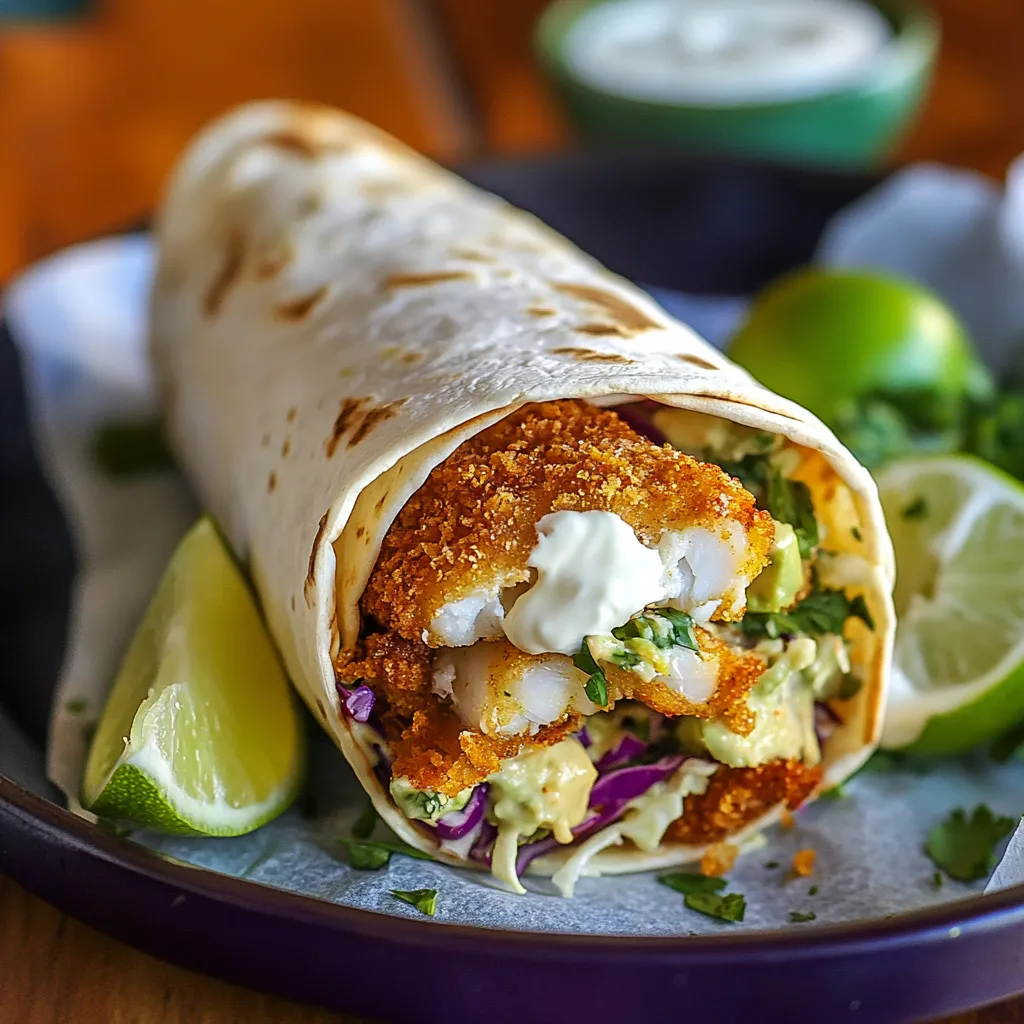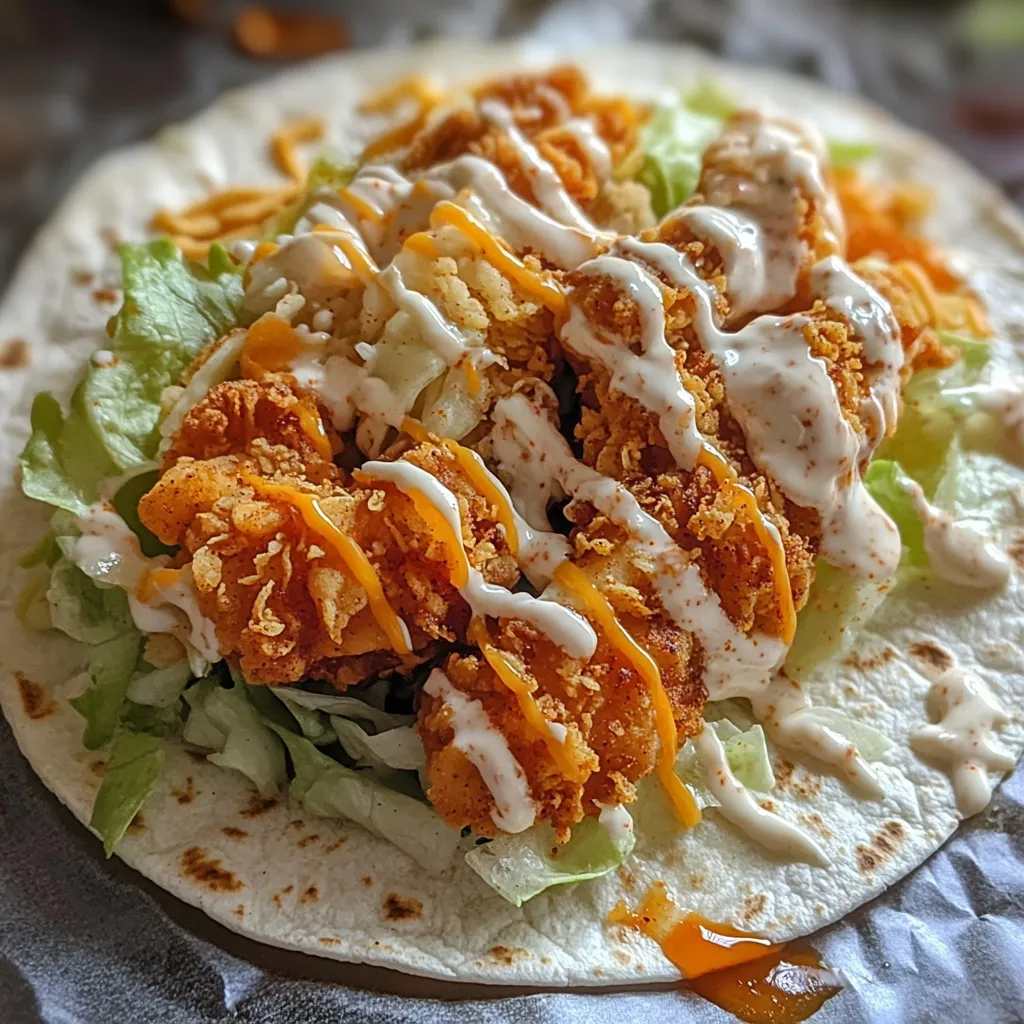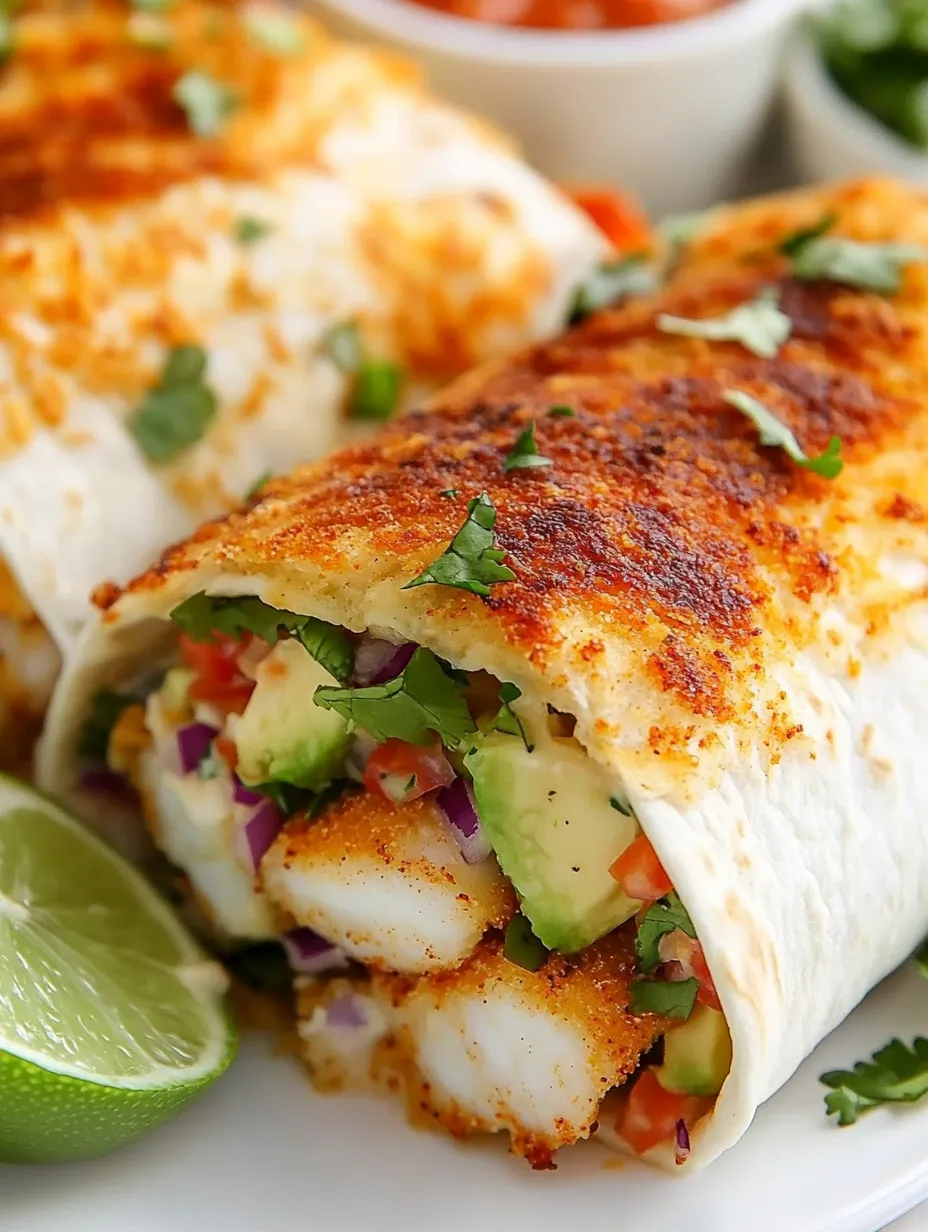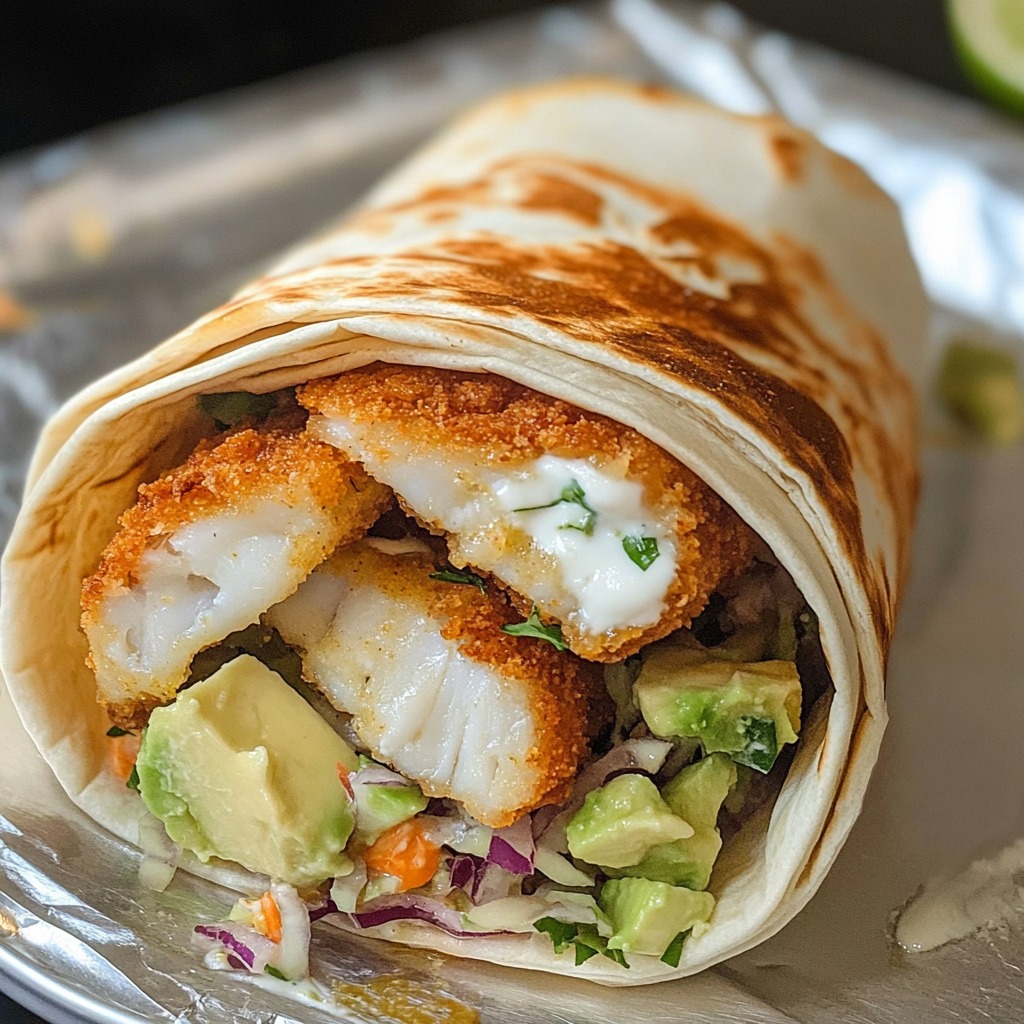 Pin it
Pin it
When you sink your teeth into a perfectly-made Crunchy Tilapia Burrito, something magical happens. That wonderful contrast between the crisp breaded fish and soft tortilla wrap, the way the cool herb-filled slaw adds brightness to each mouthful, and how the tangy lime sauce ties everything together - it's a perfect dance of textures and tastes that takes you straight to coastal California. In my home, this dish has grown from a simple street food copy to a family must-have that brings everyone running to dinner with excitement.
Yesterday, I made these burritos for our family get-together. My brother, who normally won't touch seafood, couldn't stop talking about how tasty the seasoned fish was and ended up asking for more. What's the trick? Giving each part proper attention and letting people build their own burritos just how they want them.
Key Ingredients and Shopping Advice
- Tilapia Fillets: Go for pieces with even thickness and a clean smell. Wild-caught tastes best, but farm-raised works fine too. I've noticed fillets around 4-5 inches long fit perfectly in burritos
- Flour Tortillas: Try to get the freshest ones available, at least 12 inches across. I buy mine from a nearby Mexican shop where they make them daily. Fresh tortillas fold much better
- Cabbage for Slaw: Buy whole, crisp heads instead of pre-cut bags. The texture and taste difference is huge. I like using both green and purple kinds for color and slight flavor changes
- Avocados: Pick ones that feel slightly soft when gently squeezed. I always grab them a few days early and let them soften on my kitchen counter
What makes this burrito special is how everything comes together. Whenever I'm shopping for slaw veggies or picking avocados, I think about how each item will add to that perfect final bite. I've learned over years of making this that good stuff in means good taste out.
Step-by-Step Cooking Guide
- Step 1:
- Start your burrito journey with the coating. Set up your breading area - I put mine in order: seasoned flour, beaten eggs with a splash of hot sauce, and panko crumbs mixed with salt. Dry your tilapia completely with paper towels - this step really matters for getting that golden outside we want.
- Step 2:
- Add a bit of salt and pepper to each piece of fish, then start coating. First in flour, shake off extra, then into egg, letting drips fall off. Last, press firmly into panko, covering all sides. Put the coated fish on a wire rack for about 10 minutes - this helps the coating stick better when cooking.
- Step 3:
- While the fish sits, make your herb slaw. Cut cabbage into thin strips - I like cutting by hand for better texture that holds sauce nicely. Mix in a bowl with chopped red onion, fresh cilantro, and diced avocado. In another bowl, mix your herb sauce with fresh lime juice. Pour over the veggies and mix gently. Let it sit at least 15 minutes for flavors to blend.
- Step 4:
- Now for the lime sauce. Mix sour cream, mayo, and fresh squeezed lime juice in a small bowl. Add hot sauce bit by bit, tasting as you go - remember, you can add more heat but can't take it away. I put my sauce in a squeeze bottle to make drizzling easier during assembly.
- Step 5:
- Heat your oil to 350°F - if you don't have a thermometer, drop in a breadcrumb; it should bubble gently and turn gold in about 30 seconds. Carefully put your coated fish in the oil, doing small batches to avoid crowding. Cook about 3-4 minutes each side until golden brown. Move to a paper towel-lined plate and sprinkle with salt while still hot.
- Step 6:
- Assembly time combines art and skill. Warm tortillas on a dry pan or over a gas flame - you want them soft but not crispy. Spread a thin layer of sour cream across the bottom third, add plenty of herb slaw, then place a crispy fish piece in the middle, drizzle with lime sauce, and add cheese if you want.
- Step 7:
- Here's how to roll perfectly: fold in both sides, then lift the bottom edge over the filling. Keep rolling forward while holding everything tight with your fingertips. The trick is keeping firm but gentle pressure the whole time. I learned through lots of messy attempts that loose rolling means filling falls out with every bite.
 Pin it
Pin it
Growing up near the sea, we always had fish on our table, but I didn't truly get how amazing a fish burrito could be until I found the local taco trucks. The vendor who taught me about properly drying the fried fish showed me that sometimes the smallest tips make the biggest difference.
Getting Flavor Into Your Fish
While the coating gives you crunch, a quick 15-minute soak can really boost your tilapia's taste. A simple mix of lime juice, garlic, and a bit of cumin works wonders. Don't leave it longer than 15 minutes though - the lime acid will start cooking the fish.
Frying Done Right
Oil temperature really matters for that perfect golden coating. Too hot, and the outside burns before the inside cooks; too cool, and you'll end up with oily, soft breading. I keep it steady at 350°F with a thermometer, adjusting the heat as needed.
Balancing Different Textures
The mix of textures makes these burritos unforgettable. Each part needs to keep its own character - crunchy fish, crisp slaw, smooth avocado, and soft tortilla. I've found that eating right after making is crucial. If you need to prepare ahead, keep everything separate until the last minute.
 Pin it
Pin it
Making It As Spicy As You Like
Not everyone likes the same amount of heat. I've learned to keep extra hot sauce and pickled jalapeños on the side, letting each person add their own spice level. The lime sauce also helps cool down any extra heat, working as a nice balance.
Weekend Prep Plan
Sunday afternoon has become my get-ready time for weekday burritos. I make extra herb sauce, chop the cabbage early, and mix the dry coating ingredients. This ahead-of-time work makes weeknight assembly super quick without cutting corners on quality.
My kitchen mistakes taught me these tricks - like the time I rushed the coating process for a dinner party and ended up with patchy, falling-apart breading. Now I take my time with each step, knowing the extra care makes all the difference.
 Pin it
Pin it
More Thoughts and Tips
Making the perfect fish burrito is like leading a band where timing, temperature, and technique must all work together perfectly. Through many attempts in my kitchen, I've learned that success comes not just from good ingredients, but from understanding how they work together. The crunch of well-breaded tilapia builds the foundation, while the herb slaw adds freshness and texture. The lime sauce brings it all together, creating a balanced, complete bite.
I've noticed people connect with this food on a deeper level than just filling their stomachs. It reminds them of beach trips, casual meals with friends, or their favorite local taco place. That's what's great about a well-made fish burrito - it feels both familiar and exciting, comfortable yet special.
My Journey With This Dish
I started making this recipe years ago in my tiny apartment kitchen, trying to copy the flavors from my favorite beachside taco stand. Each try taught me something new - about cooking, about patience, about using good ingredients. I still remember the first time I got the crispy coating just right, how my daughter smiled at that perfect crunch, the many friends who've gathered in my kitchen making their own perfect combinations.
This dish has grown beyond just cooking steps; it shows how I think about food: respecting old methods while not being afraid to make changes based on personal taste and experience. Whenever I make these burritos, I think about the vendors who shared their secrets, the family members who gave suggestions, and the friends who've enjoyed so many versions.
Food History and Culture
The fish burrito shows the wonderful growth of Southern California's coastal cooking. Coming from the meeting of Mexican food traditions and California's fresh seafood, it shows how food changes and grows across cultures and generations. What began as simple street food has become a loved favorite, showing the region's love for fresh ingredients and bold flavors.
Adding herb slaw and lime sauce shows how this dish keeps changing, bringing in ideas from different cooking styles while keeping its basic character. It's a good example of California's role as a food melting pot, where traditional recipes meet new ideas to create something uniquely tasty and culturally important.
Frequently Asked Questions
- → Can I swap frozen fish for fresh tilapia?
- Absolutely! Bread and fry fresh fish yourself, but frozen fillets save you time.
- → How do I make them milder?
- Leave out hot sauce and serrano peppers. Go for mild salsa or a basic pico de gallo.
- → Can I prepare these earlier?
- Best enjoyed fresh! The fish loses crispiness and slaw softens over time.
- → What's the easiest way to cook the fish?
- Bake, air fry, or pan fry—whichever method makes them crispy for assembling.
- → Can I use this recipe for tacos?
- Sure! Just swap the large wraps for small corn tortillas to make tasty tacos.
